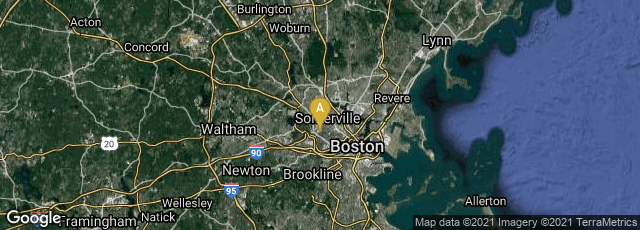

A: Cambridge, Massachusetts, United States
In "Self Pattern recognition and modern computers," Proceedings of the Western Joint Computer Conference (1955) 91–93, English artificial intelligence researcher Oliver Selfridge described one of the first attempts to devise an optical character-reading program by “teaching” the computer to extract the significant features of a given letter-pattern from a background of irrelevant detail.
“This involved getting the machine to accept slightly different versions of the same typed symbol as exactly that—different versions of the same symbol. In attacking this problem Selfridge launched a project that continues to absorb energy, the project of making machines recognize certain slightly different configurations of elements as constituting the same pattern (or, looking at it in another way, getting the machine to recognize the same identities as the human being). Visual pattern recognition was Selfridge’s particular concern, but, in its general form, pattern recognition is a fundamental topic in almost all AI projects” (Pratt, Thinking Machines. The Evolution of Artificial Intelligence [1987] 204).Selfridge, a native of England, matriculated at MIT at the age of fourteen. He published a paper on neural nets in 1948 (Archives of the Institute of Cardiology of Mexico [1948]: 177–87) and in 1955 organized with Marvin Minsky the first conference on AI.
Selfridge, a native of England, matriculated at MIT at the age of fourteen. He published a paper on neural nets in 1948 (Archives of the Institute of Cardiology of Mexico [1948]: 177–87) and in 1955 organized with Marvin Minsky the first summer conference on AI.
In an interview, "Oliver Selfridge—in from the start, IEEE Expert 11, no. 5 (1996) 15-17, Selfridge discussed his early involvement with artificial intelligence:
"Q: How did you become interested in AI?
Oliver Selfridge: It was at MIT, a long time before the Dartmouth Conference, and I was studying mathematics under Norbert Wiener. By luck, of which I’ve had a great deal in my life, I was introduced to Walter Pitts, who was working with Warren McCulloch on a topic they called theoretical neurophysiology. I had studied logic, and through Walter, Warren, and Norbert got introduced to neural nets at that time. I went to the Pacific at the end of World War II with the United States Navy and came back to graduate school, again at MIT. Norbert was then writing Cybernetics, and Walter and I were helping him with various aspects of it. As I studied mathematics (my original field) and interacted with Norbert, Warren, and Walter, I began to be interested in the specific processing that neural nets could do and even more interested in the general properties of learning.
At this point McCulloch and Pitts had written the first two AI papers (although it wasn’t called that). The first showed that a neural net could work out certain kinds of problems, such as pattern recognition in the general cognitive sense, and the second discussed acquisition of patterns (how we know “universals”). These two works followed all the glorious mathematics that Turing and Gödel had done in the twenties and thirties about computability and Turing machines. This mathematics was, of course, the beginning of a formal description of what computability meant. Johnny Von Neumann visited us at MIT occasionally, so again by pure luck, before the age of twenty, I had been introduced to McCulloch, Pitts, Wiener, and Von Neumann."
Hook & Norman, Origins of Cyberspace (2002) No. 877.
(This entry was last revised on 04-19-2014.)